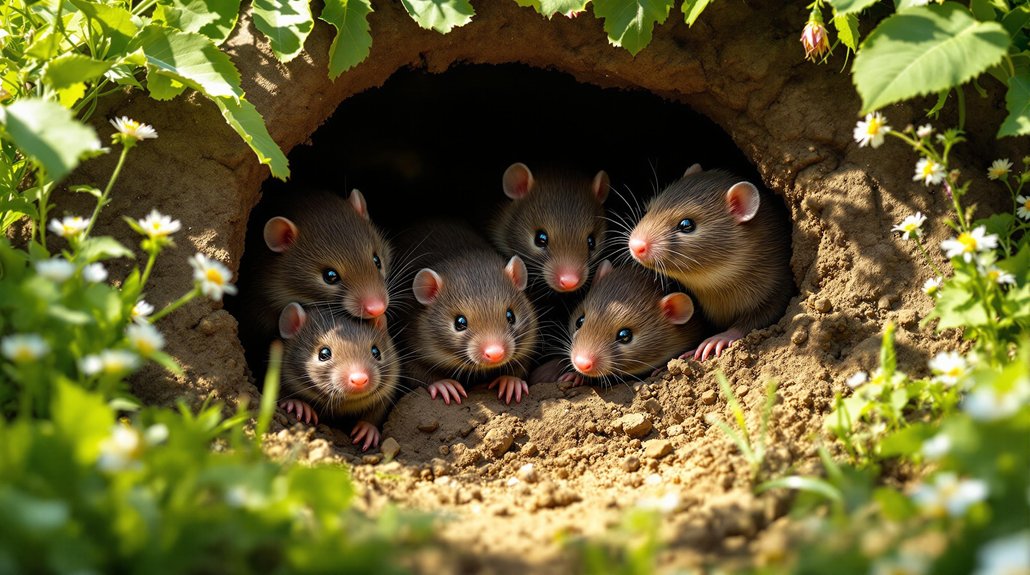Moles show different social behaviors depending on their species. Some moles live alone, while others form small groups or family units. The size of these groups can vary based on food availability and environmental conditions. In regions with abundant resources, moles may live together in larger numbers. During breeding seasons, they are more likely to share burrows for protection and resource sharing. Their cooperative behaviors also support survival in challenging environments. To fully understand the complexities of mole social structures, their living patterns in various habitats offer more insights into their fascinating lives.
Key Article Highlights
- Moles exhibit varying social structures; some species prefer solitary living while others form small groups based on environmental conditions.
- Group size among moles often depends on food availability; abundant resources can support larger groups.
- Species that live in groups typically share burrows during breeding seasons to enhance survival and resource sharing.
- Harsh weather can temporarily increase group size as moles seek shelter together.
- Cooperative behaviors, such as resource sharing and tunnel building, are common among moles living in groups.
Mole Social Structures
Moles often exhibit complex social structures that vary by species. These structures can reveal much about their communication and behavior. Moles use various mole communication methods to interact with each other, which include scent marking and vocalizations. These methods help establish territory and identify individuals within a group.
In some species, social interactions are particularly important during mating seasons. Mating rituals can involve elaborate displays and behaviors that allow moles to find suitable partners. These rituals may include specific movements or sounds that are vital for attracting mates and ensuring reproductive success.
Some mole species prefer to live in solitary conditions, while others may form small groups. The level of social interaction can depend on environmental factors, available resources, and specific species traits. Understanding these social structures is essential for those who wish to serve and protect moles in their habitats. By appreciating how moles communicate and interact, we can better support their well-being and promote conservation efforts. Overall, learning about mole social structures enriches our understanding of these fascinating creatures and their role in the ecosystem.
Species-Specific Living Patterns
Living in diverse environments, different species of moles exhibit unique patterns of habitation that reflect their adaptations and ecological needs. These species-specific living patterns are shaped by their natural behaviors and social structures. For instance, some moles prefer to live in large family groups, while others are more solitary.
Mole family dynamics play an essential role in how these animals share their homes. In species that live in groups, burrow sharing is common. This behavior allows moles to conserve energy and maintain warmth, especially in colder climates. Family groups often consist of a mother and her young, working together to dig and expand their burrow systems.
In contrast, solitary species tend to establish their own territories. These moles create extensive burrow networks that they defend from others. The choice between living alone or in groups often depends on the availability of food and suitable habitat. By understanding these species-specific living patterns, we can better appreciate the diversity of moles and their unique adaptations to the environment. This knowledge also aids in efforts to conserve their habitats and safeguard their survival in the wild.
Environmental Influences on Group Size
Group size among moles is greatly influenced by environmental factors, including food availability, habitat type, and climate conditions. The presence of adequate food sources is essential. When food is plentiful, moles can sustain larger groups. Conversely, if food is scarce, smaller groups or solitary living may occur.
Habitat availability also plays a significant role. Moles thrive in environments with rich soil and ample cover. Areas with good habitat allow for higher population density, as moles can find shelter and resources more easily. In contrast, poor habitats often lead to reduced group sizes because individuals struggle to survive.
Climate conditions can further impact group dynamics. For instance, harsh weather may force moles to seek shelter together, leading to temporary increases in group size. However, during milder conditions, moles may spread out more widely to take advantage of different resources.
Cooperative Behaviors Among Moles
Cooperative behaviors among moles play a key role in their social structure. These behaviors often involve sharing resources, such as food and burrow space, which helps the group thrive. Understanding these dynamics can provide insights into how moles maintain their communities and support one another.
Social Structure of Moles
Although often perceived as solitary creatures, moles exhibit a surprisingly complex social structure that includes various forms of cooperative behavior. These small mammals engage in specific mole communication methods to interact with one another. They use vocalizations and scents to convey information about their environment and each other. This communication is essential for maintaining social bonds and coordinating activities.
One of the most notable cooperative behaviors among moles is their group foraging strategies. While they may dig independently, moles often work in groups to locate food sources more efficiently. By sharing information about the presence of earthworms or insects, they increase the chances of a successful hunt. This teamwork allows them to cover larger areas and find food more quickly than they would alone.
In addition to foraging, moles may also assist each other in building and maintaining their tunnels. This collaboration strengthens their social ties and helps create a more stable living environment. Overall, the social structure of moles is a reflection of their ability to adapt and thrive in their underground habitats while supporting one another through cooperation.
Resource Sharing Dynamics
Moles demonstrate notable behaviors regarding resource sharing that further illustrate their social dynamics. These small mammals engage in cooperative behaviors that benefit their community. Resource allocation is a significant part of their interactions. When food or nesting areas are available, moles often share these resources with others in their group. This sharing reduces competition and enhances survival for all.
Moles employ various competition strategies to manage resources effectively. Instead of fighting over limited food, they may work together to find and share it. This approach allows them to thrive in their environment. For example, when one mole discovers a rich source of earthworms or roots, it may signal others to join in. This cooperation guarantees that everyone in the group can benefit from the find.
Moreover, sharing resources helps to strengthen social bonds among moles. By working together, they create a supportive community. This unity can be vital in harsh conditions where resources are scarce. Overall, the resource sharing dynamics of moles highlight their cooperative nature and the importance of collaboration in their social structure. This behavior not only aids individual survival but also fosters a strong communal spirit among them.
Territoriality and Social Interactions
Territoriality plays a key role in how moles interact with one another. Each mole establishes its own territory, which helps to reduce conflict over resources. Understanding these territory boundaries can provide insight into the social behavior dynamics among moles.
Mole Territory Boundaries
In the underground world of moles, territory boundaries play a significant role in their social interactions and overall behavior. Each mole establishes a specific mole territory that they defend against others. This territory provides access to food and shelter, which are imperative for survival.
Moles use various methods for boundary marking to communicate with one another. They often leave scent markers in their territory, signaling to other moles that the area is occupied. This scent marking helps reduce conflicts and maintains order within their environment.
When a mole encounters the boundary of another's territory, it usually retreats rather than confronts. This behavior shows the importance of respecting established boundaries and allows moles to coexist without frequent fighting.
Territory boundaries can vary in size based on the availability of resources and the species of the mole. In some cases, moles may share borders with neighboring territories, which can lead to limited interaction. Understanding these boundaries is essential for those who wish to appreciate the complex social structure of moles. By studying their territorial behavior, we can gain insights into their lives and the delicate balance they maintain underground.
Social Behavior Dynamics
The dynamics of social behavior among moles are primarily shaped by their territorial instincts and interactions with one another. Moles rely on various mole communication signals to establish their presence and maintain order in their habitats. These signals can include scent markings and vocalizations, which help define boundaries and alert others to their territory.
Moles often exhibit complex subterranean family dynamics. They may live in small groups, promoting cooperation, especially during breeding seasons. Social interactions can vary, from aggressive encounters to more harmonious relationships within family units.
Here is a simple table that summarizes the key aspects of mole social behavior:
| Aspect | Description | Importance |
|---|---|---|
| Communication Signals | Scent markings and vocalizations | Define territory and alert others |
| Family Structure | Small groups often centered around breeding | Promotes cooperation and support |
| Territorial Behavior | Aggressive defense of boundaries | Guarantees resource availability |
| Interaction Styles | Ranges from aggression to cooperation | Maintains group harmony |
Understanding these dynamics is vital for appreciating how moles coexist and thrive within their environments.
Adaptations for Underground Living
Moles frequently exhibit remarkable adaptations that enable them to thrive in their underground environment. Their burrowing adaptations are essential for digging tunnels and creating homes where they can find food and shelter. Moles have strong, paddle-like front limbs that allow them to dig efficiently through soil. These limbs are muscular and well-suited for the repetitive motion of burrowing.
Furthermore, moles possess a unique body structure that helps them navigate underground. Their streamlined shape minimizes resistance as they move through narrow tunnels. They also have sensitive whiskers and specialized sensory organs that aid in subterranean navigation. This helps them locate food, such as earthworms and insects, even in complete darkness.
Moles have a special adaptation in their fur, which lies flat against their bodies. This feature allows them to move easily in both directions within their tunnels. Additionally, they can close their ears and nostrils while digging, preventing dirt from entering. These adaptations guarantee that moles can live successfully beneath the surface, demonstrating their ability to adapt to a challenging environment. Understanding these traits helps us appreciate the essential roles moles play in soil health and ecosystem balance.
Frequently Asked Questions
How Do Moles Communicate With Each Other Underground?
Moles communicate underground primarily through vocalizations signals and scent marking. These methods allow them to convey information about territory, mating, and danger, fostering social structures within their subterranean environments and enhancing their survival.
What Predators Threaten Mole Populations?
Mole populations face threats from various predator species, including foxes, birds of prey, and weasels. These environmental impacts can disrupt their habitats, leading to decreased survival rates and potential declines in mole populations over time.
Do Moles Have Any Natural Enemies?
What threats do moles face in their underground world? Mole predators include birds of prey and snakes, while competition from other burrowing animals further challenges their survival, highlighting the complex dynamics of their subterranean ecosystem.
What Is the Average Lifespan of a Mole?
The average lifespan of a mole typically ranges from 2 to 6 years. Factors affecting mole behavior and lifespan include habitat quality, food availability, and predation risks, which greatly impact their overall longevity and survival.
How Do Moles Find Food in Darkness?
In the shadows of their subterranean domain, moles thrive through remarkable sensory adaptations. Their keen sense of touch and smell facilitates food detection, allowing them to navigate and forage efficiently, even in complete darkness.

